The Geography of the Solar-System
The small pocket of space, we call our solar system, is not so devoid of happenings. It’s the first thing us humans will colonize when we become a space-bearing civilization. So let’s get familiar.
Space is mostly just cold and empty, with vast distances between any two celestial objects, but there are pockets of space that are highly active and full of happenings. Our solar system is one such small pocket. Relatively speaking, there are still huge distances between any two planets in our solar system, but it is nothing compared to interstellar and intergalactic distances. So, how were these distances first measured?
In the middle of the 2nd century BCE, Greek astronomer, Hipparchus, measured the distance between Earth and the Moon using the parallax method. The technique is rudimentary. When seen from different angles, objects closer to the observer seem to shift more than objects that are further away. Using this method, Hipparchus was able to estimate the Earth-Moon distance to within 7% of the modern value, which is 384,400 km. That’s pretty impressive considering the lack of advanced tools and techniques in those times.
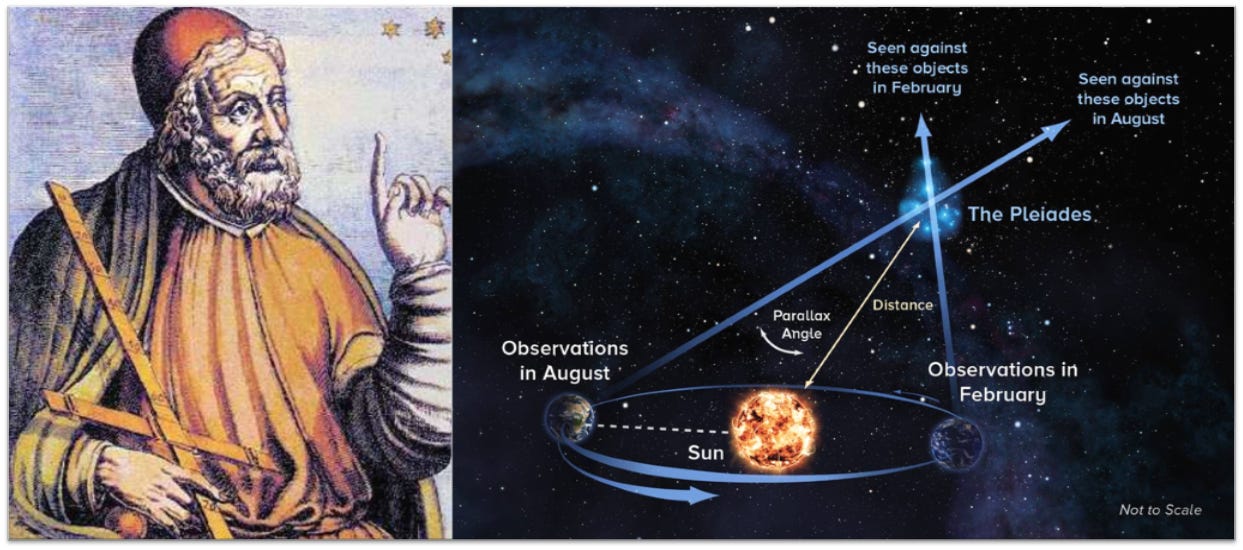
The Earth is not a perfect sphere, but the average radius of the Earth is 6,378 km. If the Earth was the size of an apple, the Moon would be the size of a marble of radius, 1 cm and would be in an orbit, around 2.4 meters away from the ‘Earth apple’.
To put into perspective, the tallest statue in the world is, ‘The statue of Unity’ which is a massive statue of the Indian statesman and independence activist Sardar Vallabhbhai Patel. Standing at a height of 182 meters, we would need around 21 Lakh statues of unity, standing on top of each other to reach from Earth to the Moon.
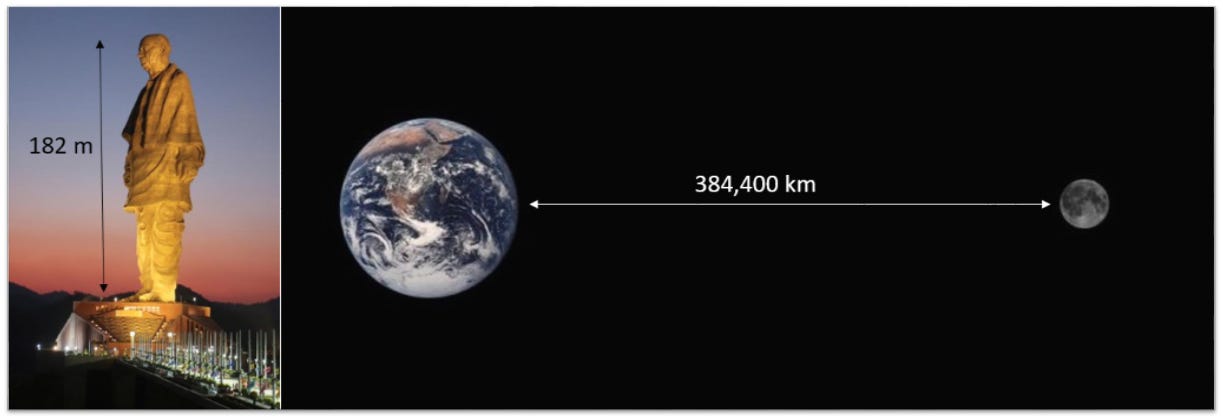
The star of the show, in the case of our Solar system, is, of course, the Sun. The Sun is the closest to ‘A perfect sphere’ in the entire solar system, with a radius of 6,96,340 km. The sun is 106 times bigger than Earth so for the ‘Earth apple’ of radius 4 cm, the Sun would be a ball of radius, 4.2 meters.
Due to the Elliptical orbit of the Earth around the sun, there is a point at which, Earth is the closest to the Sun and a point at which it’s the farthest. The average distance between the Earth and the Sun is around 15 crore km(14,88,40,000 km). To compare, the INS Vikramaditya is the Indian Navy's biggest warship. The warship has an overall length of 284 m which means we would need around 52 lakhs and 40 thousand, INS Vikramaditya attached in a line to reach from Earth to the Sun.

This distance is called 1AU (1 Astronomical unit) and is used as a standard measurement by astronomers. This unit is used mostly to measure distances in the scale of our solar system, but Interstellar distances are usually measured using Light years as units. Light-year is one of the most standard unit of measurement in the universe used by astronomers, as the speed of light is always constant in any frame of reference. One light-year is defined as the distance light travels in one year. We know the speed of light is 29,97,92,458 m/s, so in a year it would travel around 94,61,00,00,00,000 km! It takes light emitted from the surface of the Sun, around 8 minutes or 500 seconds to reach Earth and the approximate size of the solar system in terms of light-years is speculated to be around 3 light years.
The size to distance from Earth ratio for the Sun is 1: 214 and for the moon is 1: 221. Due to this fortunate coincidence, every once in a while, the Earth, Moon, and the Sun align perfectly to cause a Solar Eclipse.
Our planet is called the ‘Blue planet’ because 71% of its surface is covered with water. One Olympic pool holds up to 25,00,000 litres of water. So, it would take around 50,40,00,00,00,00,000 Olympic sized swimming pools to fill in all the water in the world. A sphere made from just all the water on Earth’s surface would have a diameter of 1385 km! Which would be even bigger than the moon of Mars, Deimos, which has a diameter of 12.4 km.
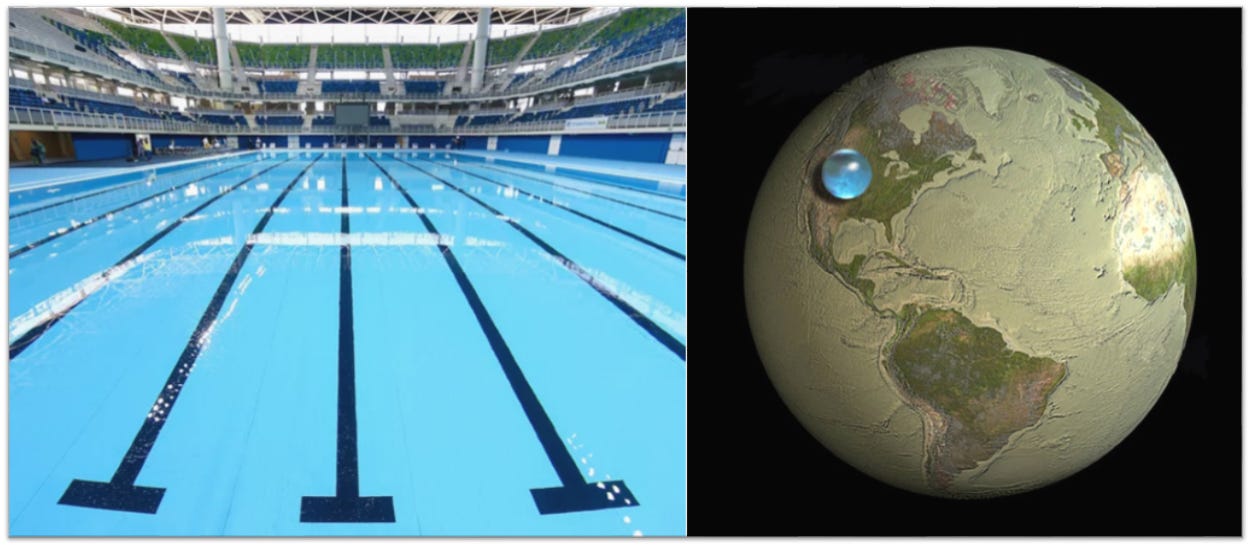
Even though our neighbouring planet Mars is around 2 times smaller than Earth, it has 2 times more moons than us. Mars is 24.2 crore km from the sun or around 2 times the distance between the Sun and Earth, It has 2 non-spherical moons Deimos (radius~12.4 km) and Phobos (radius~22 km). The surface of Mars is covered with a lot of iron oxide or rust. It’s the same compound that gives blood its red colour. This is why Mars is also called the red planet. Mars has a radius of 3,389.5 km, giving it a circumference of around 21,297 km at the equator which is only 101 km more in length than that of the Great Wall of China, the longest man-made structure which is around 21,196 km.
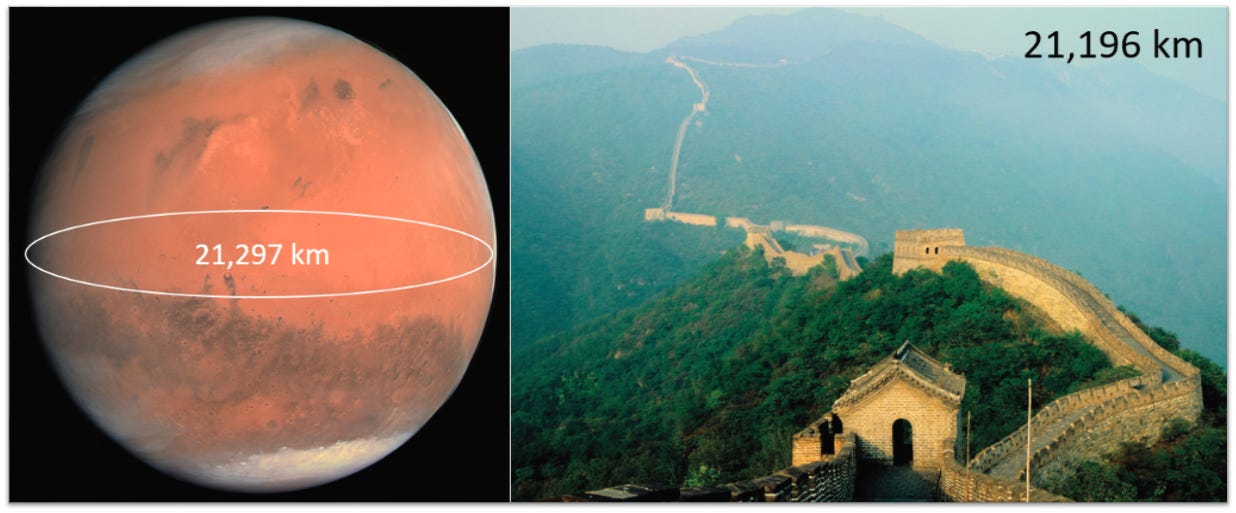
Mars has the biggest volcano in our solar system, called Olympus Mons. The tallest mountain on Earth is Mt. Everest at 8,849 m. Olympus mons is around 25 km in height, which makes it 3 times the height of Mount Everest.
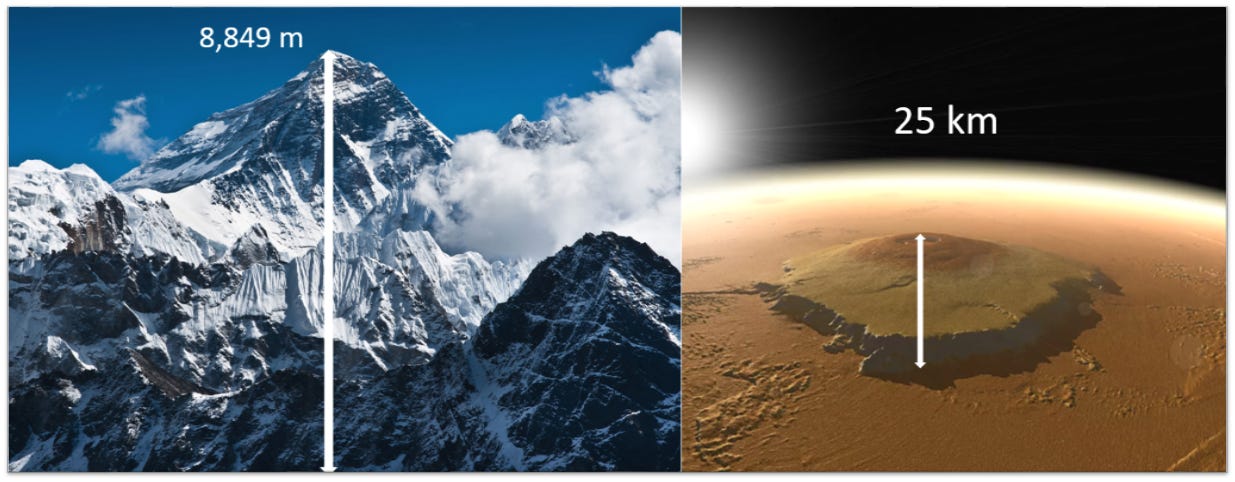
The planet closest to the Sun is Mercury, being 4.96 crore km from the Sun. One can fit 34 suns in between the Sun and Mercury. The surface temperatures on Mercury can reach up to 430 °C in the day and up to minus 180 °C at night. Even though it’s the closest to the sun, it’s not the hottest.
The hottest planet is Venus, being at 10.8 crore km from the Sun, which is around two times the distance between the Sun and Mercury. Venus is entirely covered with a thick carbon dioxide atmosphere and sulphuric acid clouds which give it a light yellowish appearance. Temperatures can rise to 464 °C on the surface. Oddly, Venus spins in the opposite direction from most other planets, which means that on Venus the sun rises in the west.
Astronomers believe that collisions between some ancient planets must have formed the asteroid belt between Mars and Jupiter. The belt lies between 2.2 and 3.2 AU and the width of the asteroid belt is around 15 crore km or 1AU, the same as the distance between the Sun and Earth. The belt is estimated to contain between 11 and 19 lakh asteroids bigger than 1 km in diameter, and millions of smaller ones. Ceres is the biggest asteroid in the belt with a radius of 473 km and is around 2.8 AU or 41.3 crore km from the sun. Ceres is now recognized as a Dwarf planet.
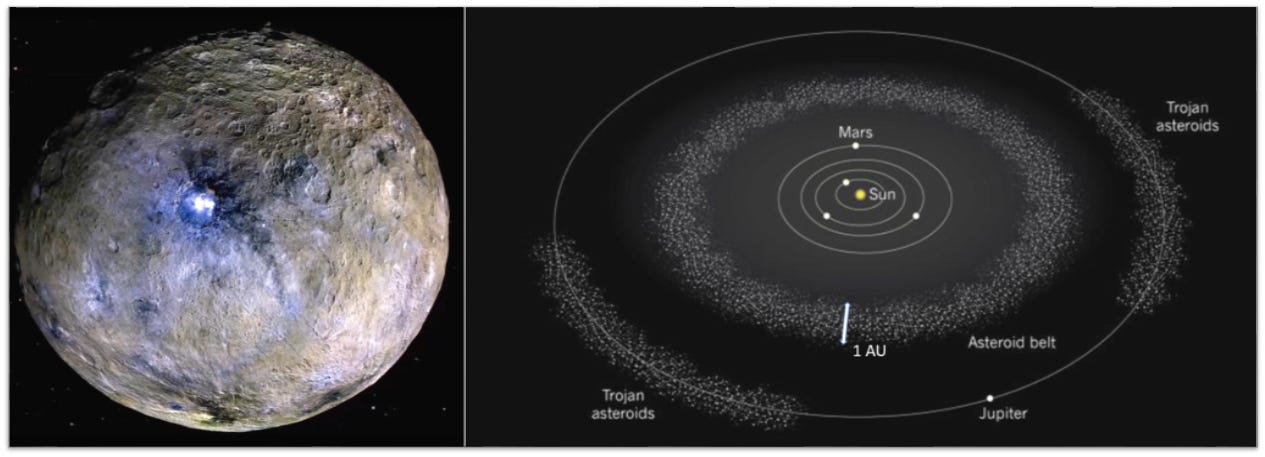
Beyond the Asteroid belt is the biggest planet in our solar system, the gas giant Jupiter, with a radius of 69,911 km, it’s around 11 times bigger than Earth, but it’s around 10 times smaller than the Sun. Jupiter is around 74 crore km from the Sun. The largest gas giant in our solar system would still need 75 times its current mass to ignite nuclear fusion in its core and become a star. The Mass of Jupiter also keeps many Trojan asteroids at bay and keeps Earth from being hit by one of them.
Jupiter has 79 moons! The biggest one is Ganymede, the largest moon in our solar system and the only moon with its own magnetic field. It’s also the only satellite with auroras, which are ribbons of glowing, electrified gas, in regions circling the moon’s north and south poles, like the ones we have on Earth. Then we have, Callisto, which is Jupiter’s second-largest moon and the third-largest moon in our solar system. Its surface is the most heavily cratered of any object in our solar system. Images of Callisto captured by passing spacecraft show bright white spots standing out against darker regions. Looking almost as if stars are scattered on its surface. Io, which is the most happening moon in our solar system, with the highest number of active Volcanos and then there’s Europa, which is the best chance for astronomers to find life beyond planet earth. It is speculated that hidden beneath its icy surface, is a salt-water ocean thought to contain twice as much water as Earth’s oceans combined, and where there’s water, life always finds a way. Together these 4 moons are called the Galilean moons in honour of Galileo Galilei.
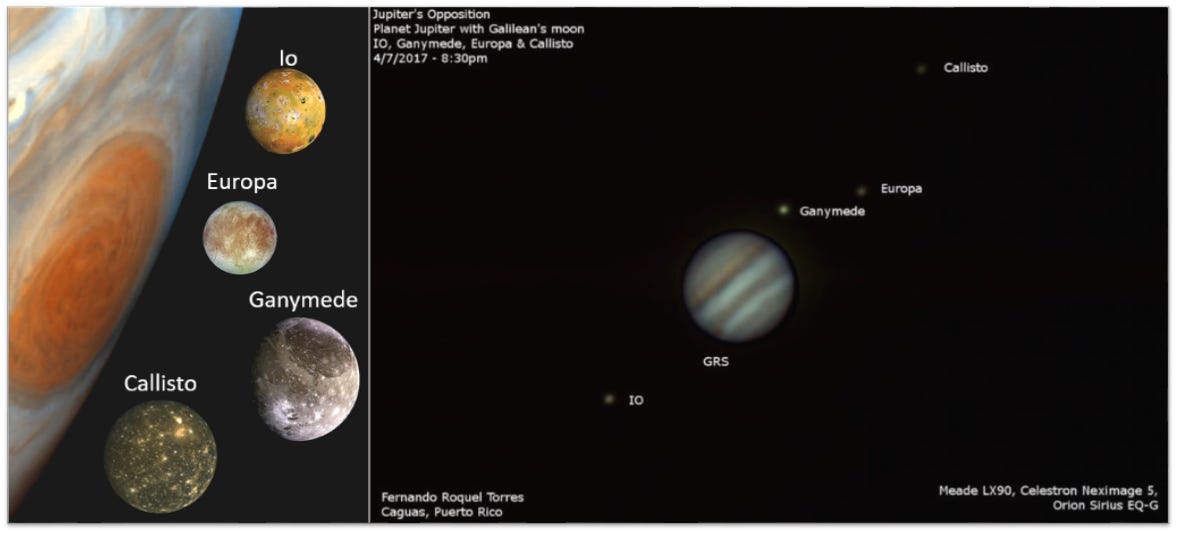
The second-largest gas giant Saturn is 148 crore km from the sun which is around twice as much as the distance between Jupiter and the Sun. It has a radius of 58,232 km and beats Jupiter when it comes to the number of moons with 82 moons!
The most prominent feature of this planet is noticeably its rings. Astronomers speculate that Saturn's rings probably formed when objects like comets, asteroids, or even moons broke up in orbit around Saturn due to Saturn's very strong gravity. These pieces kept colliding with each other and broke into even smaller pieces and gradually spread around Saturn to form its rings. The Rings extend up to 282,000 km from the planet but are only around 10 meters in height. Most of the moons of Saturn have orbits outside and beyond the rings. The moons Atlas, Epimetheus, Pandora, Daphnis and Pan are the ones nestled in and near the rings.
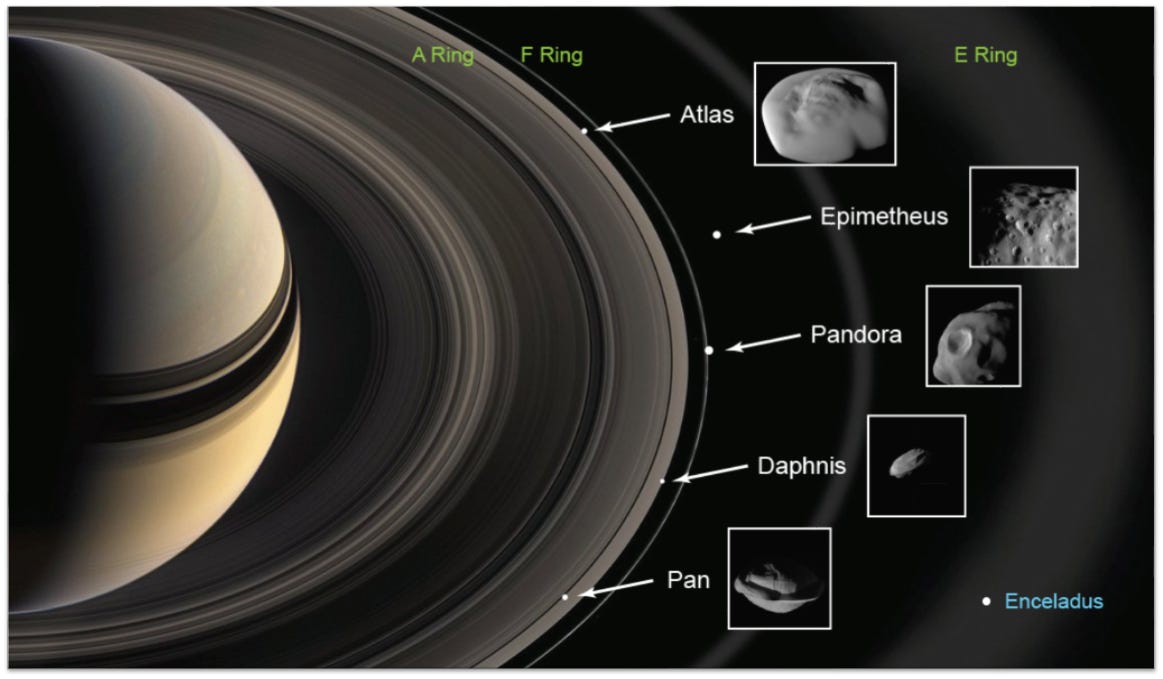
Uranus is at a distance of 279 crore km which is around 2 times the distance between Sun and Saturn. The unique thing about this planet is that it is spinning on its side, almost at a right angle to the plane of our solar system. It has a radius of 25,362 km and has two sets of rings, which, unlike Saturn’s rings, are vertical, and its 27 moons orbit the planet in their tilted plane.
The inner system of nine rings consists mostly of narrow, dark grey rings. There are two outer rings; the innermost one is reddish like dusty rings elsewhere in the solar system, whereas the outer ring is blue. Uranus' atmosphere is made up of hydrogen, helium and methane. The methane in Uranus' upper atmosphere absorbs the red light from the Sun but reflects the blue light from the Sun back into space. This is why Uranus appears blue. Uranus has 27 moons that revolve around the planet in different regions of its rings.
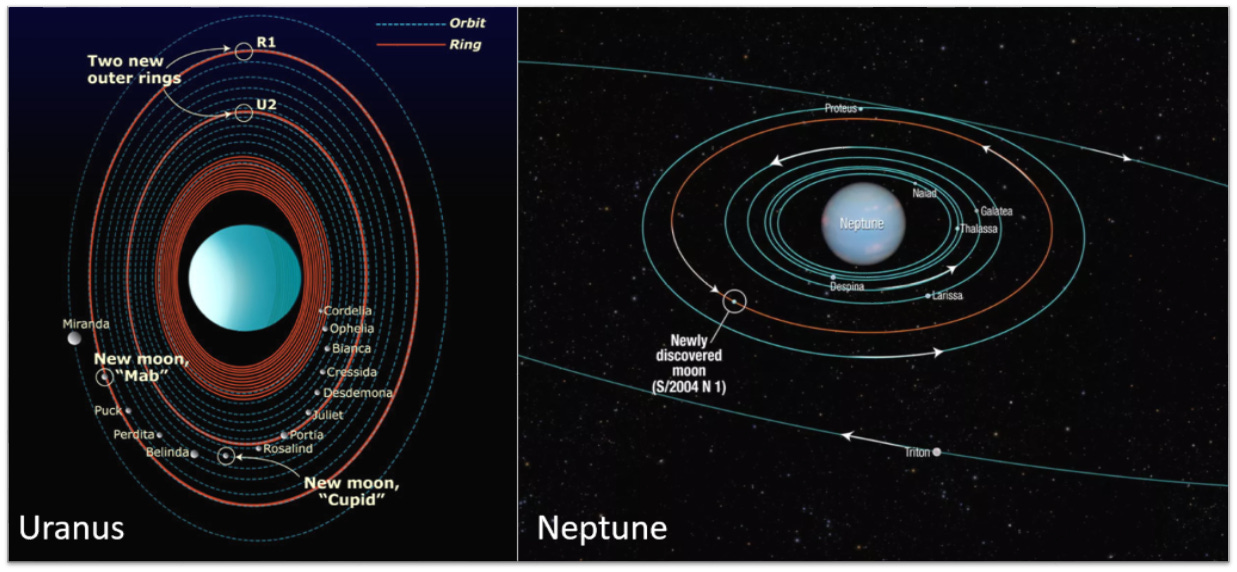
The last officially classified planet in our solar system is Neptune which is 449 crore km from the sun and has 14 known moons. Neptune’s atmosphere consists mainly of methane, which absorbs red light and infrared light, leaving behind its predominantly blue colour. The shade of Blue is called ‘azure blue’
Then comes the Kuiper belt, which is a circumstellar disc in the outer Solar System, extending from the orbit of Neptune at 30 AU to approximately 50 AU from the Sun. almost 20 times wider than the asteroid belt but almost 200 times massive.
One of the most prominent dwarf planets in the Kuiper belt is Pluto, which is around 590 crore km or 39.5 AU from the sun, which is around 40 times greater than the distance between the sun and the Earth. Even though it’s tiny compared to other planets, it still has more moons than Earth. Pluto has 5 known moons. The largest, Charon, is almost half the size of Pluto and due to that, Pluto and Charon orbit each other around a point of the centre of mass like a double planet system. Other moons are aptly named Styx, Nix, Kerberos and Hydra. All related to the God of the Underworld after whom the planet Pluto was named.
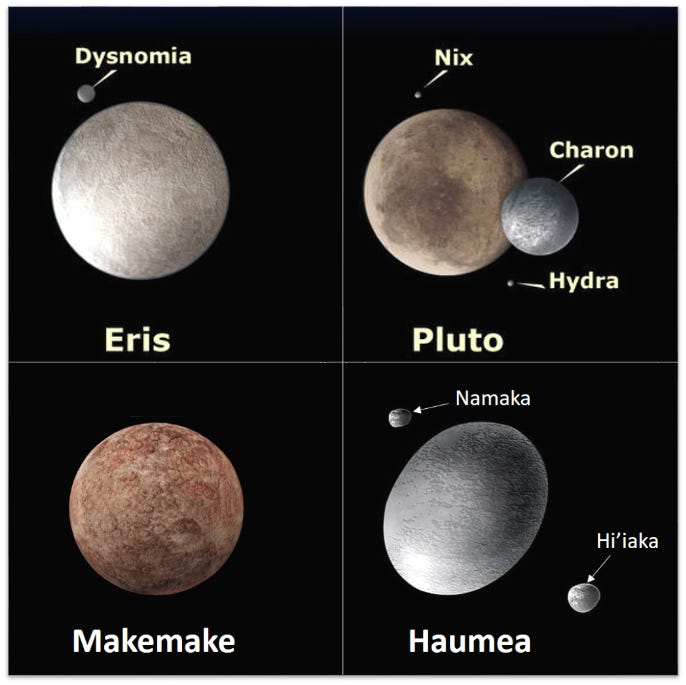
There are other dwarf planets beyond Pluto, like Eris, Haumea, and Makemake.
Eris is one of the largest known dwarf planets in our solar system and the furthest from the Sun being around 68 AU or 1012 crore km from the Sun. It's about the same size as Pluto but is three times farther from the Sun than Pluto. Even it has a moon orbiting it, named Dysnomia.
Eris is named for the ancient Greek goddess of discord and strife. The name fits since Eris remains at the centre of a scientific debate about the definition of a planet. After months of debate about how to classify Eris, the International Astronomical Union votes to change the definition of a planet. The new ruling reclassified Pluto, Eris and Ceres as dwarf planets. It has a radius of 1,163 km which is 1/5 the radius of Earth
Named after the Hawaiian goddess of fertility, the dwarf planet Haumea is roughly the same size as Pluto. It is one of the fastest rotating large objects in our solar system which makes it shaped like an ellipsoid or like an American Football. It has 2 moons. Namaka is the inner moon, and Hi'iaka is the outer moon. Both are named after the mythological daughters of Haumea. Haumea is 43 AU or 645 crore km away from the Sun. It has a radius of 620 km, which is 1/14th the radius of Earth.
And finally, Slightly smaller than Pluto is the Dwarf planet Makemake, which is the second-brightest object in the Kuiper Belt as seen from Earth, while Pluto is the brightest. It is around 45.8 AU or 684 crore km from the Sun.
The boundary between the Sun's solar wind and the interstellar medium is called the Heliopause. The sphere created by the solar winds, protect the solar system from interstellar radiation and galactic winds. The outer border of this sphere is where the solar wind's strength is no longer great enough to push back the interstellar medium.
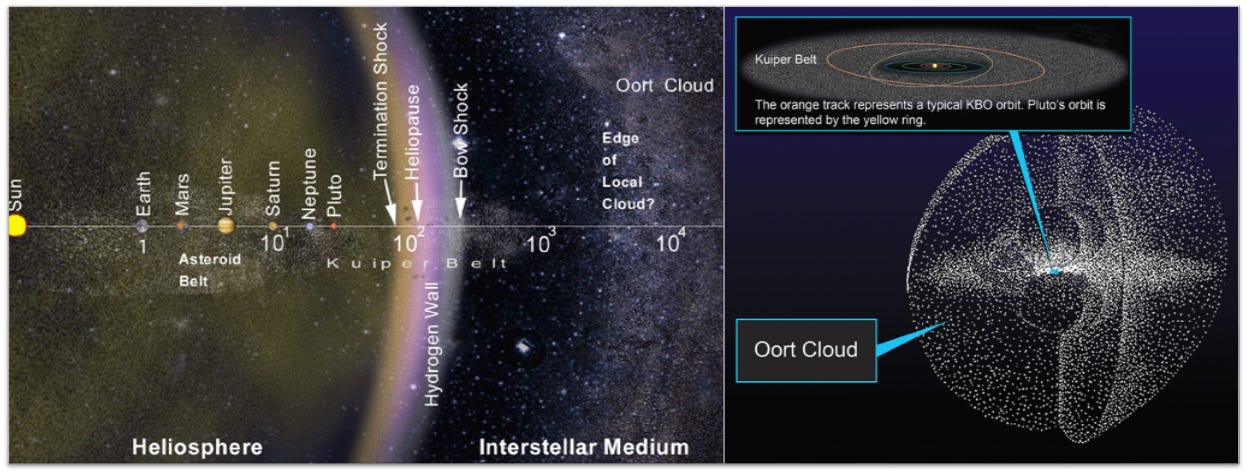
There are many other celestial bodies like Asteroids and Comets that revolve around the Sun. There are currently over 4,800 known Trojan asteroids accompanying Jupiter. In 1986, the European spacecraft Giotto became one of the first spacecraft ever to encounter and photograph the nucleus of a comet, passing and imaging Halley's nucleus as it receded from the Sun. As of April 2021, there are 4595 known comets and many more are being discovered every now and then.
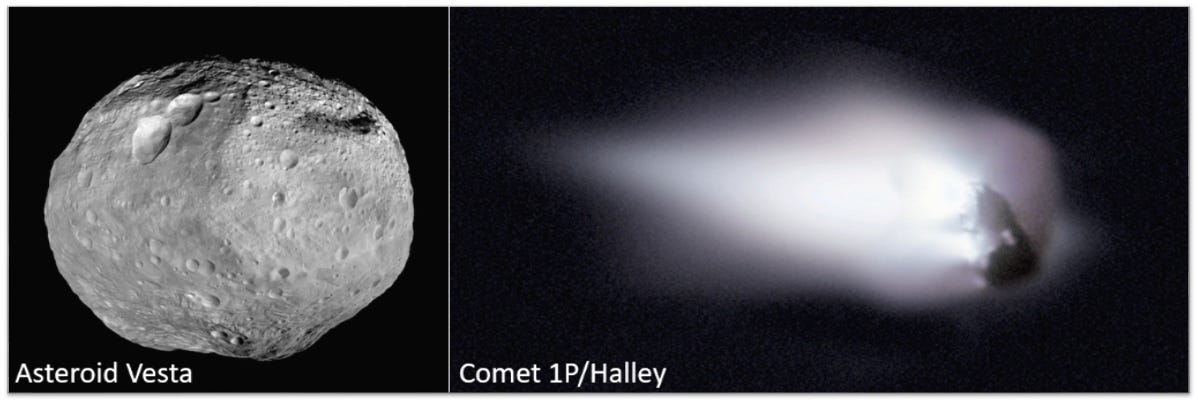
Our Solar system is still a mysterious place and many aspects of it are still vastly undiscovered but even after we become an interplanetary space faring civilization, the Solar system is going to be humanities only home for many more millenniums until efficient Interstellar travel is possible. It’s our tiny space bubble of happenings.




